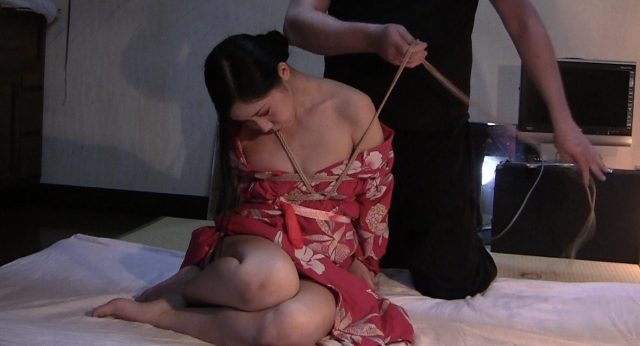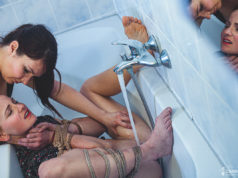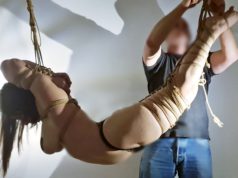I have been reading and researching a lot about the “early days” of rope in Japan. In the post-war period, it seems like people were really working hard to come to grips with the psychological aspects of what was often referred to as “abnormal sexuality.”
This was true of both the women and men, both those who tied and those who enjoyed being tied and those who liked both.
One thing that clearly emerged for me was how deeply entwined rope was with the emergence of Japanese SM. Rope and punishment were often discussed together, even as inseparable in many cases. No one seemed to be questioning why it felt good to be tied, but rather why they were drawn so powerfully to feeling bad.
In 1953, Kitan Club published Tsujimura Takashi’s “The psychological background of the impulse to do Seme” (translated by Emi Kinako and available on Kinbaku Books). As one of the participants commented “If the rope is too soft, that destroys everything. I feel somewhat bad for the model, but what I really want to see is some rough rope digging into the model’s skin.”
It is also worth mentioning that there is a discussion of how it would be impossible to suspend a model upside down. As one of them comments, “That’s probably a fake. They probably turned the image upside down and edited so it looked like what it was supposed to be.”
Which raises exactly the point I want to discuss. How rope changes as well as how it doesn’t.
Watching the rope world evolve for the past 15 years, both in the US and in Japan, I have come across a wide range of perspectives, philosophies, and approaches. Some of them are unified enough to create something that we might call a “school” or what is often termed, in Japanese, a “ryuu.”
Wayne Muromoto wrote an interesting piece about the origins of the term Ryu in martial arts. Among other things, he argues that “ryuu” refers to a source from which things flow. He contrasts this with “do” which is much closer to what we think of as technique.
I think there are problems with equating kinbaku and martial arts (for a very long list of reasons), but I think the distinction Muromoto is making can be useful when applied to a different aspect of what we do with rope, specifically heart (kokoro) and technique (katachi).
When we talk about a Ryuu, I think we are talking about both. The kokoro is the “why” and the katachi is the “how” of tying.
What I have found on my own journey is a tension between the two and it is that tension that produces a productive friction that keeps rope evolving.
Within that framework, I want to lay out what I see as four different “impulses,” if I may be so bold as to borrow from Tsujimura, to do rope. I think they can define how one approaches rope, learning, and one’s personal evolution with kinbaku.
What I have seen emerge is four different “impulses” some of which can work well together and some of which can get in the way of understanding rope at a deeper level.
First, there are people who are what I would call rope reactionaries.
A rope reactionary is someone who rejects change regardless of its value, place, or meaning. If it is new, it must be bad. They also may subscribe to a belief that one particular style is superior to all others and that other approaches are somehow less authentic or less valuable.
At the other end of the spectrum are what I would consider rope anarchists.
This approach is the polar opposite and celebrates what is new, often uncritically. It is often used as a justification for people to do whatever they want with their rope, however they want to do it. It is often confused with things like “muga” (無我), which refers to a state of selflessness or self-effacement.
The risk of rope anarchy is that it is often a shortcut for people who have neither the interest nor the discipline to learn safe technique. They do what they think looks good, without regard for issues of proper technique that is designed to keep their partners safe.
Neither of these approaches, in my estimation, do very much to further our understanding of rope. The first tends to restrict advancement, both in terms of new technique, as well as in terms of safety. We learn from our mistakes and we grow from our experience. Dogmatic insistence on the past, simply because it is the way things have been done, benefits no one.
The second, suffers from a different problem. Because rope anarchy is done without deep understanding, it is ephemeral and often not repeatable. Apart from the risks, it doesn’t do very much to help advance tying, because it eschews self-awareness for the pleasure of absolute freedom in the moment. It is impossible to build on quicksand and that is the only grounding that such a perspective is able to offer.
The middle ground is where I find the most interesting tension in the evolution of rope, between what I would consider rope conservatism on one hand and rope progressivism on the other. At the risk of carrying too much political baggage with such terms, I think each fits, in the traditional sense of each word.
Rope conservatism wants to protect what is valuable from the past. Rope progressivism wants to find better ways of doing those things that are valuable and meaningful.
In that sense, they can work together to create a productive friction between the two impulses.
When rope conservatism seeks to understand the heart of a particular approach, they are trying to identify what is meaningful, the “why” or the “source” from which the style flows.
In my own case, studying with Yukimura sensei, that was clearly the evocation of a unique blend of pleasure and shame in the person you are tying. There was no single technique to product that, but a wide range of approaches that could be everything from how you tie to how you position your body to which ear you whisper humiliating words into as you touch and caress your partner.
Spending time with someone like Naka Akira, I have found a completely different set of impulses, ones that I believe are inherited from his sensei Nureki Chimuo. When I visited Naka sensei’s last Kinbiken (a continuation of Nureki’s famous seminar series), before tying, he invited the spirit of Nureki (who passed away in 2013) to fill him and inspire him that day as he tied.
It was a remarkable moment, which I think can serve as a beautiful moment of rope conservatism, of preserving the heart, spirit, and meaning on a particular style of rope, in short the kokoro.
On the other side, however, we need to be mindful of change. And that is where rope progressivism is equally important. For a Ryuu to be alive it needs to change, grow and develop. Techniques become stale and we can learn new ways of doing things that are safer, more beautiful, or have a much better effect.
But rope progressivism is also the space of personal growth, ownership and style. How we tie will always be personal. How we do things will evolve and grow as we develop more skills and better ways to express ourselves.
Rope progressivism is at its best when it is used to advance the spirit of the style. It is grounded in a sense of meaning and understanding, but its constant drive toward change is what keeps any style alive, growing, and dramatic.
Kokoro can ground technique. It can give it a set of standards, goals, desires, and meanings. Likewise, katachi can give life to heart, it can reveal it to the world and to your partner. In the service of kokoro, building your own set of techniques, changes, and developments is essential.
To preserve the heart, you must continually evolve the technique.
As we do that, we gain a deeper understand of the essence of the style and we evolve as bakushi.
As Yukimura would say “Once you have learned the basics, please develop and enjoy your own style,” because for him, understanding the foundations and the principles were the essence of Yukimura Ryuu. The ties were a tool, a path, and means to find the heart of what he believed rope was about.
Likewise, when I watched Naka sensei tie, I saw techniques that were quite different and distinct from anything Nureki ever did. In my view, Naka’s technique has been evolving for decades to simultaneously look less and less like Nureki’s while bringing his style closer and closer to the heart of what Nureki’s style was trying to do.
When we explore the deeper aspect of kinbaku, which is to say our impulses, we are best served, I believe, by constantly working to create a friction between the old and the new, saving what is best from the past, while always striving to find new ways to bring it to fruition.
Kokoro can be the inspiration for our standards, our goals, and our understanding, which katachi can serve as the basis for inspiration and above all personal expression.
It is a battle between permanence and change, which is nothing new. What may be new is understand how we can use those tensions productively and not just be able to answer the questions “how?” and “why?” but to truly understand that you can’t truly answer either of those questions without also answering the other.







